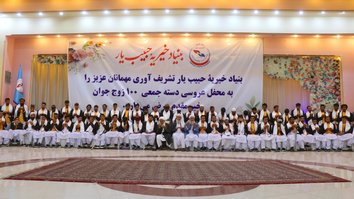NANGARHAR -- Residents of Kama District, Nangarhar Province, have resumed producing gora, a common Afghan sweet made from sugar cane that disappeared during the 1996-2001 Taliban regime.
Before the Taliban came to power in 1996, dozens of gora producing factories operated in Kama District. However, all those factories folded under Taliban rule.
A major reason was the availability of cheap Pakistani gora.
Residents of Nangarhar Province, however, favour gora made in Kama because they consider the Pakistani gora sub-standard and distrust Pakistani manufacturers' use of the artificial sweetener saccharin.
![A labourer produces gora from sugar cane juice in Kama District, Nangarhar Province, December 26. [Noorullah Shirzada/AFP]](/cnmi_st/images/2019/01/08/16104-000_1bu596-585_329.jpg)
A labourer produces gora from sugar cane juice in Kama District, Nangarhar Province, December 26. [Noorullah Shirzada/AFP]
At present, Kama has four gora factories that recently began producing the cherished sweet. All use sugar cane juice rather than saccharin.
"In previous years, not much sugar was made here because it was not profitable," Shafiqullah, a 35-year-old farmer from Noorzi village, Kama District, told Salaam Times. "People were using Pakistani gora, which contained saccharin."
Local residents, who are suspicious of saccharin's effect on health, have gone back to local, natural gora, he said.
Within Nangarhar, "sugar cane is cultivated only in Kama District," said Abdul Waris Taand, deputy director of the Nangarhar Agriculture Department.
In less than a year, the Kama District sugar cane yield "was an estimated 90 metric tonnes", he said. "Sugar cane's cultivation and gora production are expected to increase this year compared to last year."
Taand did not disclose production figures for gora. However, gora made in Kama is now being sold elsewhere in Afghanistan, he said.

![A farmer harvests sugar cane for gora production in Kama District, Nangarhar Province, December 26. [Khalid Zerai]](/cnmi_st/images/2019/01/08/16105-8-585_329.jpg)
![Sayed Rahman, 48, extracts juice from sugar cane in Kama District, Nangarhar Province, December 26. The juice is used to make gora, a traditional sweet. [Khalid Zerai]](/cnmi_st/images/2019/01/08/16106-1-585_329.jpg)
![In this photo taken on December 26, 2018, Afghan labourers prepare Gora from sugar cane juice at a traditional factory in the Kama District, Nangarhar Province. [NOORULLAH SHIRZADA / AFP]](/cnmi_st/images/2019/01/08/16107-2-585_329.jpg)
![An Afghan worker at a Gora-making factory in Kama District adds more dried sugar canes to the oven as he produces Gora on December 26. [Khalid Zerai]](/cnmi_st/images/2019/01/08/16108-6-585_329.jpg)
![A worker stirs sugar cane's juice for at least two hours before they begin baking Gora in Kama District, Nangarhar Province, on December 26. [Khalid Zerai]](/cnmi_st/images/2019/01/08/16109-4-585_329.jpg)
![Workers add walnuts to half-baked sugar cane juice before making gora in Kama District, Nangarhar Province, December 26. [Khalid Zerai]](/cnmi_st/images/2019/01/08/16110-5-585_329.jpg)
![Workers give shape to baked sugar cane juice in Kama District, Nangarhar Province, December 26. [Khalid Zerai]](/cnmi_st/images/2019/01/08/16112-7-585_329.jpg)
![A farmer carries stalks of sugar cane after harvest in Kama District, Nangarhar Province, December 26. [Khalid Zerai]](/cnmi_st/images/2019/01/08/16113-10-585_329.jpg)
![A farmer prepares to cultivate sugar cane cuttings for planting on other fields in Kama District, Nangarhar Province, December 26. [Khalid Zerai]](/cnmi_st/images/2019/01/08/16114-13-585_329.jpg)




